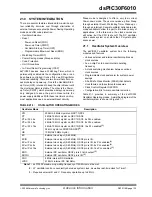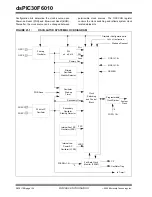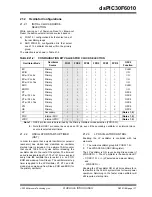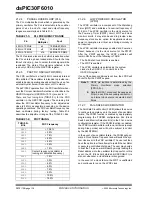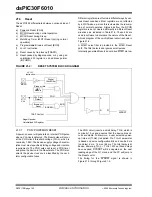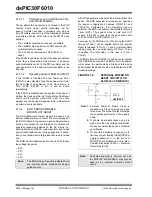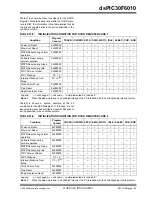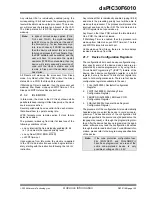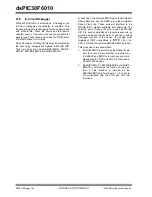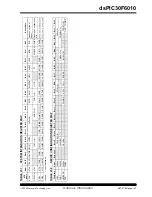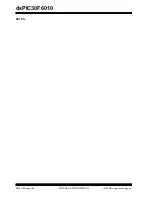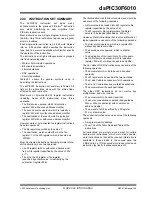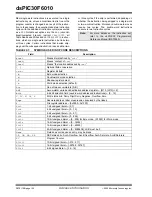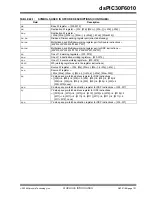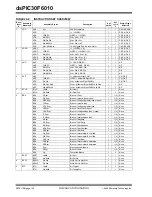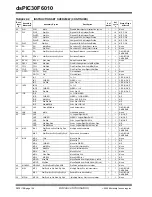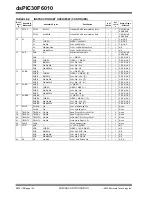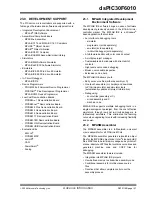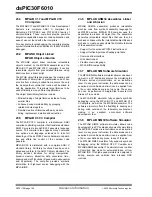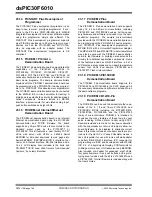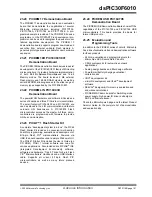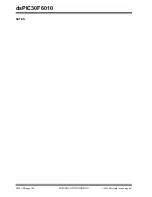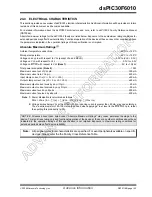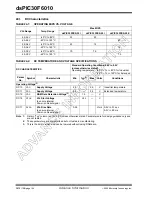
2004 Microchip Technology Inc.
Advance Information
DS70119B-page 149
dsPIC30F6010
22.0 INSTRUCTION SET SUMMARY
The dsPIC30F instruction set adds many
enhancements to the previous PICmicro
®
instruction
sets, while maintaining an easy migration from
PICmicro instruction sets.
Most instructions are a single program memory word
(24-bits). Only three instructions require two program
memory locations.
Each single-word instruction is a 24-bit word divided
into an 8-bit opcode which specifies the instruction
type, and one or more operands which further specify
the operation of the instruction.
The instruction set is highly orthogonal and is grouped
into five basic categories:
• Word or byte-oriented operations
• Bit-oriented operations
• Literal operations
• DSP operations
• Control operations
Table 22-1 shows the general symbols used in
describing the instructions.
The dsPIC30F instruction set summary in Table 22-2
lists all the instructions along with the status flags
affected by each instruction.
Most word or byte-oriented W register instructions
(including barrel shift instructions) have three
operands:
• The first source operand, which is typically a
register ‘Wb’ without any address modifier
• The second source operand, which is typically a
register ‘Ws’ with or without an address modifier
• The destination of the result, which is typically a
register ‘Wd’ with or without an address modifier
However, word or byte-oriented file register instructions
have two operands:
• The file register specified by the value ‘f’
• The destination, which could either be the file
register ‘f’ or the W0 register, which is denoted as
‘WREG’
Most bit oriented instructions (including simple rotate/
shift instructions) have two operands:
• The W register (with or without an address modi-
fier) or file register (specified by the value of ‘Ws’
or ‘f’)
• The bit in the W register or file register
(specified by a literal value, or indirectly by the
contents of register ‘Wb’)
The literal instructions that involve data movement may
use some of the following operands:
• A literal value to be loaded into a W register or file
register (specified by the value of ‘k’)
• The W register or file register where the literal
value is to be loaded (specified by ‘Wb’ or ‘f’)
However, literal instructions that involve arithmetic or
logical operations use some of the following operands:
• The first source operand, which is a register ‘Wb’
without any address modifier
• The second source operand, which is a literal
value
• The destination of the result (only if not the same
as the first source operand), which is typically a
register ‘Wd’ with or without an address modifier
The
MAC
class of DSP instructions may use some of the
following operands:
• The accumulator (A or B) to be used (required
operand)
• The W registers to be used as the two operands
• The X and Y address space pre-fetch operations
• The X and Y address space pre-fetch destinations
• The accumulator write back destination
The other DSP instructions do not involve any
multiplication, and may include:
• The accumulator to be used (required)
• The source or destination operand (designated as
Wso or Wdo, respectively) with or without an
address modifier
• The amount of shift, specified by a W register
‘Wn’ or a literal value
The control instructions may use some of the following
operands:
• A program memory address
• The mode of the Table Read and Table Write
instructions
All instructions are a single word, except for certain
double-word instructions, which were made double-
word instructions so that all the required information is
available in these 48-bits. In the second word, the
8 MSb’s are 0’s. If this second word is executed as an
instruction (by itself), it will execute as a
NOP
.
Summary of Contents for dsPIC30F6010
Page 12: ...dsPIC30F6010 DS70119B page 10 Advance Information 2004 Microchip Technology Inc NOTES...
Page 32: ...dsPIC30F6010 DS70119B page 30 Advance Information 2004 Microchip Technology Inc NOTES...
Page 38: ...dsPIC30F6010 DS70119B page 36 Advance Information 2004 Microchip Technology Inc NOTES...
Page 50: ...dsPIC30F6010 DS70119B page 48 Advance Information 2004 Microchip Technology Inc NOTES...
Page 68: ...dsPIC30F6010 DS70119B page 66 Advance Information 2004 Microchip Technology Inc NOTES...
Page 72: ...dsPIC30F6010 DS70119B page 70 Advance Information 2004 Microchip Technology Inc NOTES...
Page 76: ...dsPIC30F6010 DS70119B page 74 Advance Information 2004 Microchip Technology Inc NOTES...
Page 86: ...dsPIC30F6010 DS70119B page 84 Advance Information 2004 Microchip Technology Inc NOTES...
Page 108: ...dsPIC30F6010 DS70119B page 106 Advance Information 2004 Microchip Technology Inc NOTES...
Page 116: ...dsPIC30F6010 DS70119B page 114 Advance Information 2004 Microchip Technology Inc NOTES...
Page 128: ...dsPIC30F6010 DS70119B page 126 Advance Information 2004 Microchip Technology Inc NOTES...
Page 150: ...dsPIC30F6010 DS70119B page 148 Advance Information 2004 Microchip Technology Inc NOTES...
Page 164: ...dsPIC30F6010 DS70119B page 162 Advance Information 2004 Microchip Technology Inc NOTES...
Page 208: ...dsPIC30F6010 DS70119B page 206 Advance Information 2004 Microchip Technology Inc NOTES...
Page 220: ...dsPIC30F6010 DS70119B page 220 Advance Information 2004 Microchip Technology Inc NOTES...
Page 221: ...2004 Microchip Technology Inc Advance Information DS70119B page 221 dsPIC30F6010 NOTES...

